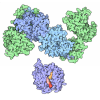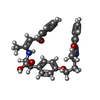[English] 日本語
 Yorodumi
Yorodumi- PDB-1k7l: The 2.5 Angstrom resolution crystal structure of the human PPARal... -
+ Open data
Open data
- Basic information
Basic information
| Entry | Database: PDB / ID: 1k7l | ||||||
|---|---|---|---|---|---|---|---|
| Title | The 2.5 Angstrom resolution crystal structure of the human PPARalpha ligand binding domain bound with GW409544 and a co-activator peptide. | ||||||
 Components Components |
| ||||||
 Keywords Keywords | TRANSCRIPTION / The 2.5 Angstrom resolution crystal structure of the human PPARalpha ligand binding domain bound with GW409544 and a coactivator peptide | ||||||
| Function / homology |  Function and homology information Function and homology informationpositive regulation of transformation of host cell by virus / regulation of fatty acid transport / enamel mineralization / positive regulation of fatty acid beta-oxidation / regulation of ketone metabolic process / cellular response to fructose stimulus / regulation of fatty acid metabolic process / negative regulation of cell growth involved in cardiac muscle cell development / negative regulation of appetite / negative regulation of hepatocyte apoptotic process ...positive regulation of transformation of host cell by virus / regulation of fatty acid transport / enamel mineralization / positive regulation of fatty acid beta-oxidation / regulation of ketone metabolic process / cellular response to fructose stimulus / regulation of fatty acid metabolic process / negative regulation of cell growth involved in cardiac muscle cell development / negative regulation of appetite / negative regulation of hepatocyte apoptotic process / positive regulation of fatty acid oxidation / lipoprotein metabolic process / behavioral response to nicotine / negative regulation of leukocyte cell-cell adhesion / labyrinthine layer morphogenesis / positive regulation of transcription from RNA polymerase II promoter by galactose / regulation of thyroid hormone receptor signaling pathway / positive regulation of female receptivity / negative regulation of glycolytic process / ubiquitin conjugating enzyme binding / mitogen-activated protein kinase kinase kinase binding / NR1H2 & NR1H3 regulate gene expression to control bile acid homeostasis / DNA-binding transcription activator activity / positive regulation of fatty acid metabolic process / male mating behavior / NFAT protein binding / hypothalamus development / negative regulation of cholesterol storage / positive regulation of ATP biosynthetic process / nuclear steroid receptor activity / cellular response to Thyroglobulin triiodothyronine / Synthesis of bile acids and bile salts / negative regulation of macrophage derived foam cell differentiation / progesterone receptor signaling pathway / epidermis development / Synthesis of bile acids and bile salts via 27-hydroxycholesterol / Endogenous sterols / Synthesis of bile acids and bile salts via 7alpha-hydroxycholesterol / response to retinoic acid / phosphatase binding / estrous cycle / nuclear retinoid X receptor binding / positive regulation of lipid biosynthetic process / histone acetyltransferase activity / cellular response to hormone stimulus / Recycling of bile acids and salts / Transcriptional regulation of brown and beige adipocyte differentiation by EBF2 / histone acetyltransferase / NR1H3 & NR1H2 regulate gene expression linked to cholesterol transport and efflux / negative regulation of blood pressure / intracellular receptor signaling pathway / nitric oxide metabolic process / estrogen receptor signaling pathway / negative regulation of reactive oxygen species biosynthetic process / hormone-mediated signaling pathway / lactation / : / positive regulation of adipose tissue development / Regulation of lipid metabolism by PPARalpha / MDM2/MDM4 family protein binding / peroxisome proliferator activated receptor signaling pathway / response to nutrient / positive regulation of gluconeogenesis / positive regulation of neuron differentiation / negative regulation of cytokine production involved in inflammatory response / regulation of cellular response to insulin stimulus / negative regulation of phosphatidylinositol 3-kinase/protein kinase B signal transduction / BMAL1:CLOCK,NPAS2 activates circadian expression / SUMOylation of transcription cofactors / Activation of gene expression by SREBF (SREBP) / response to progesterone / negative regulation of miRNA transcription / cerebellum development / cellular response to starvation / nuclear estrogen receptor binding / nuclear receptor binding / gluconeogenesis / RNA polymerase II transcription regulatory region sequence-specific DNA binding / hippocampus development / SUMOylation of intracellular receptors / circadian regulation of gene expression / wound healing / mRNA transcription by RNA polymerase II / Heme signaling / negative regulation of transforming growth factor beta receptor signaling pathway / fatty acid metabolic process / Transcriptional activation of mitochondrial biogenesis / PPARA activates gene expression / response to insulin / Cytoprotection by HMOX1 / regulation of circadian rhythm / cerebral cortex development / Nuclear Receptor transcription pathway / Transcriptional regulation of white adipocyte differentiation / negative regulation of inflammatory response / DNA-binding transcription repressor activity, RNA polymerase II-specific / transcription coactivator binding / RNA polymerase II transcription regulator complex / male gonad development / nuclear receptor activity Similarity search - Function | ||||||
| Biological species |  Homo sapiens (human) Homo sapiens (human) | ||||||
| Method |  X-RAY DIFFRACTION / X-RAY DIFFRACTION /  SYNCHROTRON / Resolution: 2.5 Å SYNCHROTRON / Resolution: 2.5 Å | ||||||
 Authors Authors | Xu, H.E. / Lambert, M.H. / Montana, V.G. / Moore, L.B. / Collins, J.L. / Oplinger, J.A. / Kliewer, S.A. / Gampe Jr., R.T. / McKee, D.D. / Moore, J.T. / Willson, T.M. | ||||||
 Citation Citation |  Journal: Proc.Natl.Acad.Sci.USA / Year: 2001 Journal: Proc.Natl.Acad.Sci.USA / Year: 2001Title: Structural determinants of ligand binding selectivity between the peroxisome proliferator-activated receptors. Authors: Xu, H.E. / Lambert, M.H. / Montana, V.G. / Plunket, K.D. / Moore, L.B. / Collins, J.L. / Oplinger, J.A. / Kliewer, S.A. / Gampe Jr., R.T. / McKee, D.D. / Moore, J.T. / Willson, T.M. | ||||||
| History |
|
- Structure visualization
Structure visualization
| Structure viewer | Molecule:  Molmil Molmil Jmol/JSmol Jmol/JSmol |
|---|
- Downloads & links
Downloads & links
- Download
Download
| PDBx/mmCIF format |  1k7l.cif.gz 1k7l.cif.gz | 236.2 KB | Display |  PDBx/mmCIF format PDBx/mmCIF format |
|---|---|---|---|---|
| PDB format |  pdb1k7l.ent.gz pdb1k7l.ent.gz | 191.2 KB | Display |  PDB format PDB format |
| PDBx/mmJSON format |  1k7l.json.gz 1k7l.json.gz | Tree view |  PDBx/mmJSON format PDBx/mmJSON format | |
| Others |  Other downloads Other downloads |
-Validation report
| Summary document |  1k7l_validation.pdf.gz 1k7l_validation.pdf.gz | 653.7 KB | Display |  wwPDB validaton report wwPDB validaton report |
|---|---|---|---|---|
| Full document |  1k7l_full_validation.pdf.gz 1k7l_full_validation.pdf.gz | 727.2 KB | Display | |
| Data in XML |  1k7l_validation.xml.gz 1k7l_validation.xml.gz | 33.2 KB | Display | |
| Data in CIF |  1k7l_validation.cif.gz 1k7l_validation.cif.gz | 48.5 KB | Display | |
| Arichive directory |  https://data.pdbj.org/pub/pdb/validation_reports/k7/1k7l https://data.pdbj.org/pub/pdb/validation_reports/k7/1k7l ftp://data.pdbj.org/pub/pdb/validation_reports/k7/1k7l ftp://data.pdbj.org/pub/pdb/validation_reports/k7/1k7l | HTTPS FTP |
-Related structure data
- Links
Links
- Assembly
Assembly
| Deposited unit | 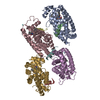
| ||||||||
|---|---|---|---|---|---|---|---|---|---|
| 1 | 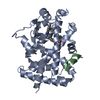
| ||||||||
| 2 | 
| ||||||||
| 3 | 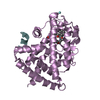
| ||||||||
| 4 | 
| ||||||||
| Unit cell |
|
- Components
Components
| #1: Protein | Mass: 32731.014 Da / Num. of mol.: 4 / Fragment: ligand binding domain - residues 192 - 468 Source method: isolated from a genetically manipulated source Source: (gene. exp.)  Homo sapiens (human) / Plasmid: T7 promoter control plasmid / Production host: Homo sapiens (human) / Plasmid: T7 promoter control plasmid / Production host:  #2: Protein/peptide | Mass: 2431.750 Da / Num. of mol.: 4 / Fragment: src-1 peptide / Source method: obtained synthetically Details: Chemically synthesized 21mer portion of the the human src-1 coactivator peptide. References: UniProt: O43792, UniProt: Q15788*PLUS #3: Chemical | ChemComp-544 / #4: Chemical | #5: Water | ChemComp-HOH / | |
|---|
-Experimental details
-Experiment
| Experiment | Method:  X-RAY DIFFRACTION / Number of used crystals: 1 X-RAY DIFFRACTION / Number of used crystals: 1 |
|---|
- Sample preparation
Sample preparation
| Crystal | Density Matthews: 2.52 Å3/Da / Density % sol: 51.17 % | ||||||||||||||||||||||||||||||||||||||||||||||||||||||||||||||||||||||
|---|---|---|---|---|---|---|---|---|---|---|---|---|---|---|---|---|---|---|---|---|---|---|---|---|---|---|---|---|---|---|---|---|---|---|---|---|---|---|---|---|---|---|---|---|---|---|---|---|---|---|---|---|---|---|---|---|---|---|---|---|---|---|---|---|---|---|---|---|---|---|---|
| Crystal grow | Temperature: 295 K / Method: vapor diffusion, hanging drop / pH: 7.5 Details: PEG 3350, NaNO3, hexanediol, YCl3, pH 7.5, VAPOR DIFFUSION, HANGING DROP, temperature 295K | ||||||||||||||||||||||||||||||||||||||||||||||||||||||||||||||||||||||
| Crystal grow | *PLUS | ||||||||||||||||||||||||||||||||||||||||||||||||||||||||||||||||||||||
| Components of the solutions | *PLUS
|
-Data collection
| Diffraction | Mean temperature: 93 K |
|---|---|
| Diffraction source | Source:  SYNCHROTRON / Site: SYNCHROTRON / Site:  APS APS  / Beamline: 17-ID / Wavelength: 1 Å / Beamline: 17-ID / Wavelength: 1 Å |
| Detector | Type: MARRESEARCH / Detector: CCD |
| Radiation | Protocol: SINGLE WAVELENGTH / Monochromatic (M) / Laue (L): M / Scattering type: x-ray |
| Radiation wavelength | Wavelength: 1 Å / Relative weight: 1 |
| Reflection | Resolution: 2.5→20 Å / Num. obs: 49991 / % possible obs: 99.9 % / Observed criterion σ(I): 0 / Biso Wilson estimate: 52.8 Å2 / Rsym value: 0.054 |
| Reflection | *PLUS Rmerge(I) obs: 0.054 |
| Reflection shell | *PLUS Mean I/σ(I) obs: 5.7 |
- Processing
Processing
| Software |
| ||||||||||||||||||||||||||||||||||||
|---|---|---|---|---|---|---|---|---|---|---|---|---|---|---|---|---|---|---|---|---|---|---|---|---|---|---|---|---|---|---|---|---|---|---|---|---|---|
| Refinement | Resolution: 2.5→19.99 Å / Rfactor Rfree error: 0.004 / Data cutoff high absF: 318526.64 / Data cutoff low absF: 0 / Isotropic thermal model: RESTRAINED / Cross valid method: THROUGHOUT / σ(F): 0
| ||||||||||||||||||||||||||||||||||||
| Displacement parameters | Biso mean: 58.3 Å2
| ||||||||||||||||||||||||||||||||||||
| Refine analyze |
| ||||||||||||||||||||||||||||||||||||
| Refinement step | Cycle: LAST / Resolution: 2.5→19.99 Å
| ||||||||||||||||||||||||||||||||||||
| Refine LS restraints |
| ||||||||||||||||||||||||||||||||||||
| LS refinement shell | Resolution: 2.5→2.66 Å / Rfactor Rfree error: 0.014 / Total num. of bins used: 6
| ||||||||||||||||||||||||||||||||||||
| Xplor file |
| ||||||||||||||||||||||||||||||||||||
| Refinement | *PLUS % reflection Rfree: 10 % / Rfactor obs: 0.247 / Rfactor Rfree: 0.285 / Rfactor Rwork: 0.247 | ||||||||||||||||||||||||||||||||||||
| Solvent computation | *PLUS | ||||||||||||||||||||||||||||||||||||
| Displacement parameters | *PLUS | ||||||||||||||||||||||||||||||||||||
| Refine LS restraints | *PLUS
| ||||||||||||||||||||||||||||||||||||
| LS refinement shell | *PLUS Rfactor Rfree: 0.365 / Rfactor Rwork: 0.308 |
 Movie
Movie Controller
Controller







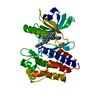
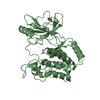
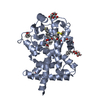

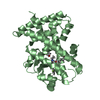
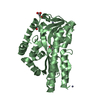
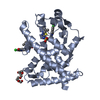

 PDBj
PDBj


